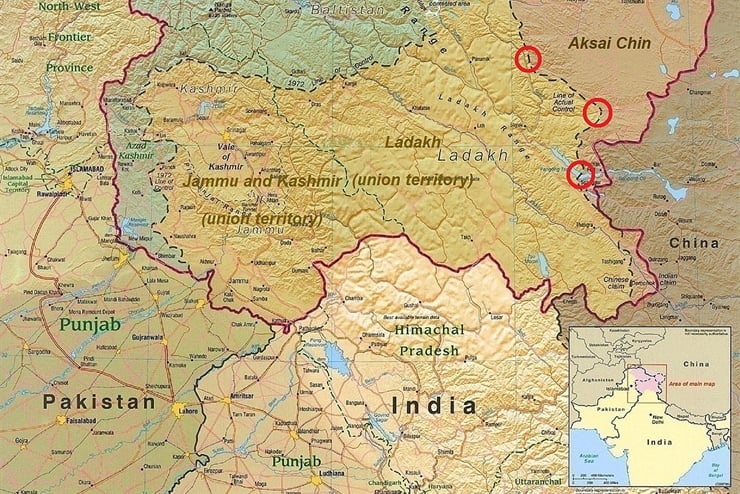A major border clash took place between Indian and Chinese troops mid-June in the Western Himalayan region of Ladakh, on the disputed “Line of Actual Control” dividing the two Asian giants. Twenty Indian soldiers died, including a senior officer, and there were 43 reported casualties on the Chinese side. This was the bloodiest in a series of clashes which have taken place at various points along the Sino-Indian border since May 5.
It appears the clashes were China’s reaction to India’s roadbuilding project in an area administered by India but which Beijing claims as part of its Tibet Autonomous Region. Over the past 20 years India has built some 3,000 miles of roads in its northernmost region. Last year the government of Prime Minister Narendra Modi imposed direct rule from Delhi over Jammu and Kashmir—which is claimed by Pakistan—as well as Ladakh, to China’s additional chagrin.
On Aug. 5, India’s old rival Pakistan joined the fray when its foreign minister unveiled a new political map that shows Kashmir as Pakistani territory. Pakistan has close relations with China, manifested in the ongoing construction of the China–Pakistan Economic Corridor which will link China’s westernmost regions with the port of Gwadar on the Indian Ocean.
The geopolitical implications of renewed tensions in the subcontinent have not received sufficient attention in U.S. media. The conflict indicates that China wants to preempt India’s emergence as a member of “The Quad” of Western-aligned allies in the Indo-Pacific region, along with the U.S., Japan, and Australia. The new thinking in Beijing seems to be that China needs to show determination on its southwestern flank in order to strengthen its claims in the South China Sea, add muscle to its dealings with America, and convince India that it is better off staying out of the U.S.’s orbit.
Chinese proponents of strong-arming India can point out that relations were quickly stabilized after India’s defeat in the undeclared 1962 war in the Himalayas, in which India was deeply humiliated. Far from seeking revenge against China and trying to rely on one of the two superpowers, India under Prime Minister Jawaharlal Nehru and his successors returned to the principles of the Non-Aligned Movement and stayed neutral in the Cold War. Neither Moscow nor Washington could count on Delhi in their plans to contain Beijing.
In pursuing an assertive course vis-à-vis its southern neighbor, China’s strategic planners may feel emboldened by the apparent success of their bid to establish control over the South China Sea. The U.S. Navy makes periodic “freedom of navigation” forays into the disputed archipelagos which have been militarized by the Chinese Army in recent years. In July the USS Ronald Reagan and USS Nimitz carrier strike groups thus conducted exercises in “Asia’s Mediterranean,” and Secretary of State Mike Pompeo declared that “the world will not allow Beijing to treat the South China Sea as its maritime empire.”
The regional balance has shifted decisively in China’s favor, however. Its “carrier killer” anti-ship missiles make it prohibitively risky for American capital ships to come anywhere near their range in a real crisis. “China is now capable of controlling the South China Sea in all scenarios short of war with the United States,” Admiral Philip Davidson told the U.S. Senate in 2018. This makes nonsense of any strategy preventing China from fortifying its maritime Silk Road connecting the South China Sea with the Indian Ocean.
China’s strategy seems to be working. Indian government officials have stated repeatedly that border tensions would have no impact on trade between the two countries and have rejected calls for boycotting Chinese goods. Indian analysts warned that a boycott would be counterproductive since both bilaterally and globally India is the far weaker side. Until the late 1970s China’s per capita income was lower than that of India, but today it is almost five times higher.
In Delhi’s foreign policy community, the consensus is that any military escalation would be both unaffordable and unlikely to achieve India’s strategic objectives. “The Quad” does not offer a viable counterstrategy. Australia cannot afford to risk its well-nigh complete economic interdependence with China, and Japan will not accept risks for the sake of India’s precarious hold on some distant mountaintops.
As for America, the prudent strategy is to let the two Asian giants sort out their mutual relations as they see fit. The danger is real that an overt expression of U.S. support for Modi, let alone a formal alliance which would bring the U.S. Navy into Indian ports, would increase the risk of some future crisis between Washington and Beijing spiraling out of control. It is in America’s interest to reduce its overseas commitments, not extend them, as domestically it sinks ever deeper into a moral, social, and cultural crisis unprecedented in any great power’s history.
Image Credit:
above: A 2004 CIA map of the disputed Kashmir region with red circles corresponding to 2020 conflicts at the Galwan Valley (top), Hot Springs checkpoint (middle), and Pangong Tso (bottom). [Image by: United States Central Intelligence Agency / in the Public domain, via Wikemedia Commons, cropped and resized]

Leave a Reply